Full Case Study Presentation Narrative
VerifiedAdded on 2022/09/16
|11
|1936
|21
AI Summary
Contribute Materials
Your contribution can guide someone’s learning journey. Share your
documents today.

Running Head: Full Case Study Presentation Narrative
FULL CASE STUDY PRESENTATION NARRATIVE
FULL CASE STUDY PRESENTATION NARRATIVE
Secure Best Marks with AI Grader
Need help grading? Try our AI Grader for instant feedback on your assignments.

2
Full Case Study Presentation Narrative
Table of Contents
Introduction................................................................................................................................3
Conceptualization.......................................................................................................................3
Process........................................................................................................................................4
Outcomes....................................................................................................................................4
Discussion..................................................................................................................................5
Conclusion..................................................................................................................................6
Reference list..............................................................................................................................7
Appendix....................................................................................................................................9
Full Case Study Presentation Narrative
Table of Contents
Introduction................................................................................................................................3
Conceptualization.......................................................................................................................3
Process........................................................................................................................................4
Outcomes....................................................................................................................................4
Discussion..................................................................................................................................5
Conclusion..................................................................................................................................6
Reference list..............................................................................................................................7
Appendix....................................................................................................................................9
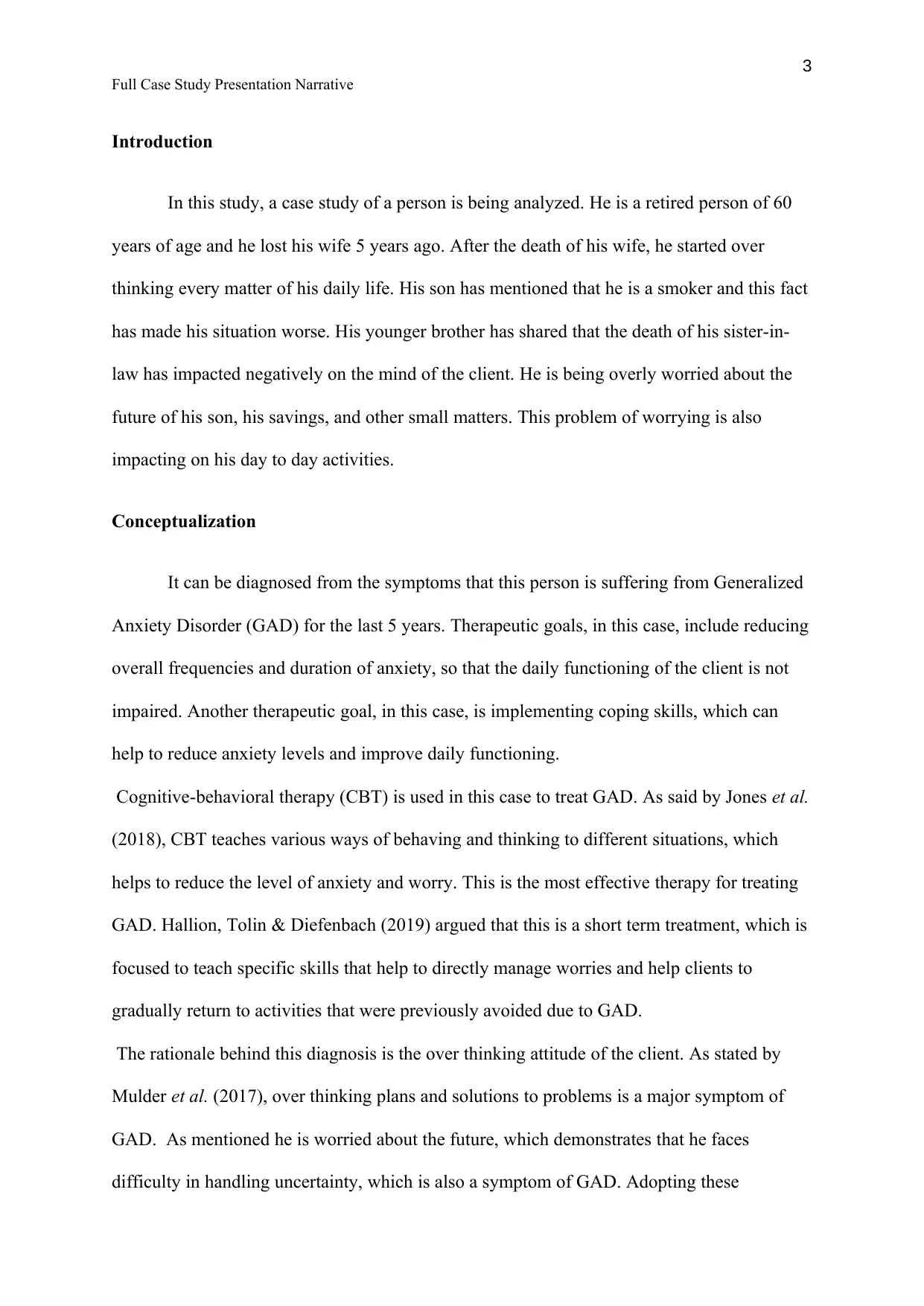
3
Full Case Study Presentation Narrative
Introduction
In this study, a case study of a person is being analyzed. He is a retired person of 60
years of age and he lost his wife 5 years ago. After the death of his wife, he started over
thinking every matter of his daily life. His son has mentioned that he is a smoker and this fact
has made his situation worse. His younger brother has shared that the death of his sister-in-
law has impacted negatively on the mind of the client. He is being overly worried about the
future of his son, his savings, and other small matters. This problem of worrying is also
impacting on his day to day activities.
Conceptualization
It can be diagnosed from the symptoms that this person is suffering from Generalized
Anxiety Disorder (GAD) for the last 5 years. Therapeutic goals, in this case, include reducing
overall frequencies and duration of anxiety, so that the daily functioning of the client is not
impaired. Another therapeutic goal, in this case, is implementing coping skills, which can
help to reduce anxiety levels and improve daily functioning.
Cognitive-behavioral therapy (CBT) is used in this case to treat GAD. As said by Jones et al.
(2018), CBT teaches various ways of behaving and thinking to different situations, which
helps to reduce the level of anxiety and worry. This is the most effective therapy for treating
GAD. Hallion, Tolin & Diefenbach (2019) argued that this is a short term treatment, which is
focused to teach specific skills that help to directly manage worries and help clients to
gradually return to activities that were previously avoided due to GAD.
The rationale behind this diagnosis is the over thinking attitude of the client. As stated by
Mulder et al. (2017), over thinking plans and solutions to problems is a major symptom of
GAD. As mentioned he is worried about the future, which demonstrates that he faces
difficulty in handling uncertainty, which is also a symptom of GAD. Adopting these
Full Case Study Presentation Narrative
Introduction
In this study, a case study of a person is being analyzed. He is a retired person of 60
years of age and he lost his wife 5 years ago. After the death of his wife, he started over
thinking every matter of his daily life. His son has mentioned that he is a smoker and this fact
has made his situation worse. His younger brother has shared that the death of his sister-in-
law has impacted negatively on the mind of the client. He is being overly worried about the
future of his son, his savings, and other small matters. This problem of worrying is also
impacting on his day to day activities.
Conceptualization
It can be diagnosed from the symptoms that this person is suffering from Generalized
Anxiety Disorder (GAD) for the last 5 years. Therapeutic goals, in this case, include reducing
overall frequencies and duration of anxiety, so that the daily functioning of the client is not
impaired. Another therapeutic goal, in this case, is implementing coping skills, which can
help to reduce anxiety levels and improve daily functioning.
Cognitive-behavioral therapy (CBT) is used in this case to treat GAD. As said by Jones et al.
(2018), CBT teaches various ways of behaving and thinking to different situations, which
helps to reduce the level of anxiety and worry. This is the most effective therapy for treating
GAD. Hallion, Tolin & Diefenbach (2019) argued that this is a short term treatment, which is
focused to teach specific skills that help to directly manage worries and help clients to
gradually return to activities that were previously avoided due to GAD.
The rationale behind this diagnosis is the over thinking attitude of the client. As stated by
Mulder et al. (2017), over thinking plans and solutions to problems is a major symptom of
GAD. As mentioned he is worried about the future, which demonstrates that he faces
difficulty in handling uncertainty, which is also a symptom of GAD. Adopting these
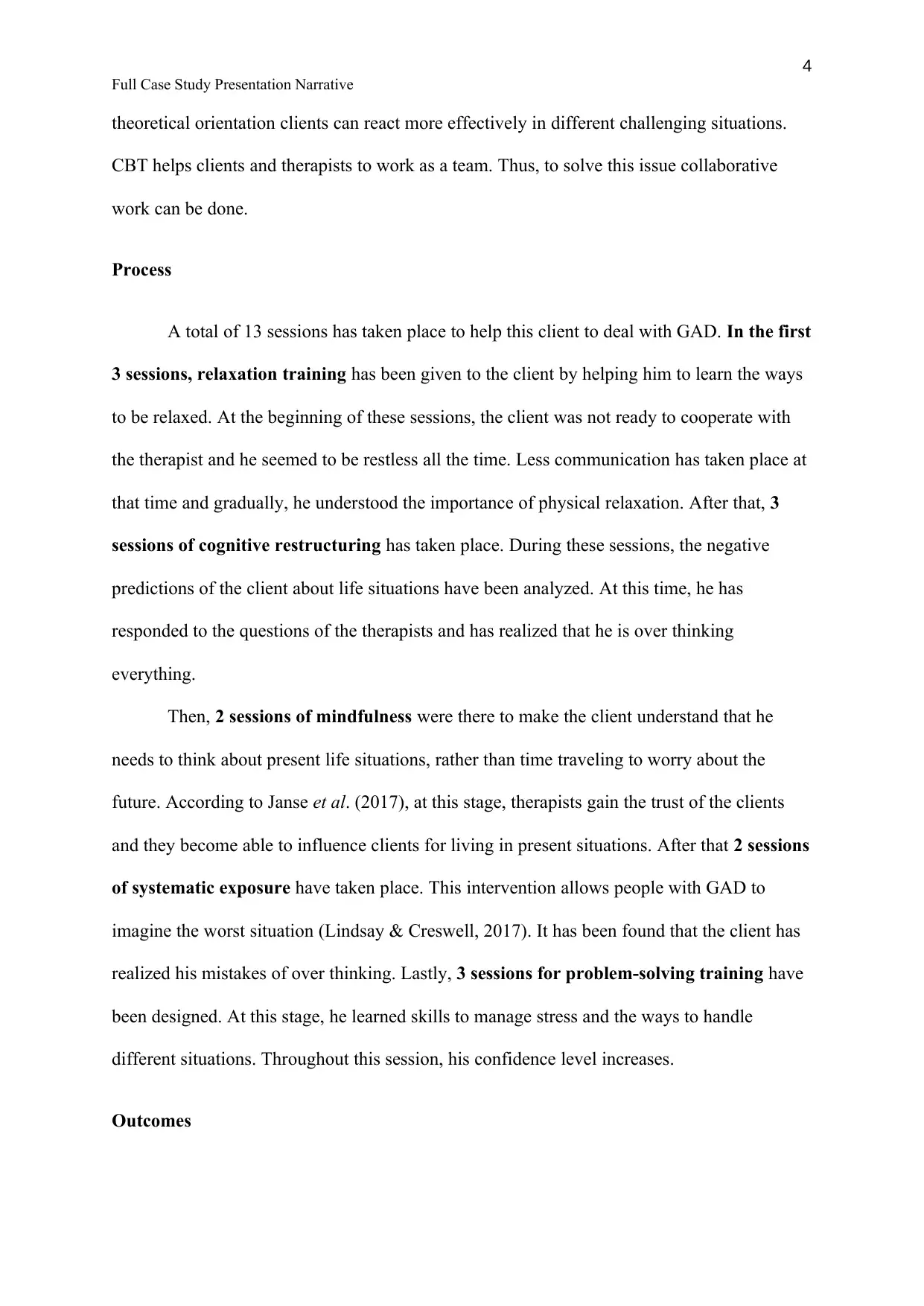
4
Full Case Study Presentation Narrative
theoretical orientation clients can react more effectively in different challenging situations.
CBT helps clients and therapists to work as a team. Thus, to solve this issue collaborative
work can be done.
Process
A total of 13 sessions has taken place to help this client to deal with GAD. In the first
3 sessions, relaxation training has been given to the client by helping him to learn the ways
to be relaxed. At the beginning of these sessions, the client was not ready to cooperate with
the therapist and he seemed to be restless all the time. Less communication has taken place at
that time and gradually, he understood the importance of physical relaxation. After that, 3
sessions of cognitive restructuring has taken place. During these sessions, the negative
predictions of the client about life situations have been analyzed. At this time, he has
responded to the questions of the therapists and has realized that he is over thinking
everything.
Then, 2 sessions of mindfulness were there to make the client understand that he
needs to think about present life situations, rather than time traveling to worry about the
future. According to Janse et al. (2017), at this stage, therapists gain the trust of the clients
and they become able to influence clients for living in present situations. After that 2 sessions
of systematic exposure have taken place. This intervention allows people with GAD to
imagine the worst situation (Lindsay & Creswell, 2017). It has been found that the client has
realized his mistakes of over thinking. Lastly, 3 sessions for problem-solving training have
been designed. At this stage, he learned skills to manage stress and the ways to handle
different situations. Throughout this session, his confidence level increases.
Outcomes
Full Case Study Presentation Narrative
theoretical orientation clients can react more effectively in different challenging situations.
CBT helps clients and therapists to work as a team. Thus, to solve this issue collaborative
work can be done.
Process
A total of 13 sessions has taken place to help this client to deal with GAD. In the first
3 sessions, relaxation training has been given to the client by helping him to learn the ways
to be relaxed. At the beginning of these sessions, the client was not ready to cooperate with
the therapist and he seemed to be restless all the time. Less communication has taken place at
that time and gradually, he understood the importance of physical relaxation. After that, 3
sessions of cognitive restructuring has taken place. During these sessions, the negative
predictions of the client about life situations have been analyzed. At this time, he has
responded to the questions of the therapists and has realized that he is over thinking
everything.
Then, 2 sessions of mindfulness were there to make the client understand that he
needs to think about present life situations, rather than time traveling to worry about the
future. According to Janse et al. (2017), at this stage, therapists gain the trust of the clients
and they become able to influence clients for living in present situations. After that 2 sessions
of systematic exposure have taken place. This intervention allows people with GAD to
imagine the worst situation (Lindsay & Creswell, 2017). It has been found that the client has
realized his mistakes of over thinking. Lastly, 3 sessions for problem-solving training have
been designed. At this stage, he learned skills to manage stress and the ways to handle
different situations. Throughout this session, his confidence level increases.
Outcomes
Secure Best Marks with AI Grader
Need help grading? Try our AI Grader for instant feedback on your assignments.
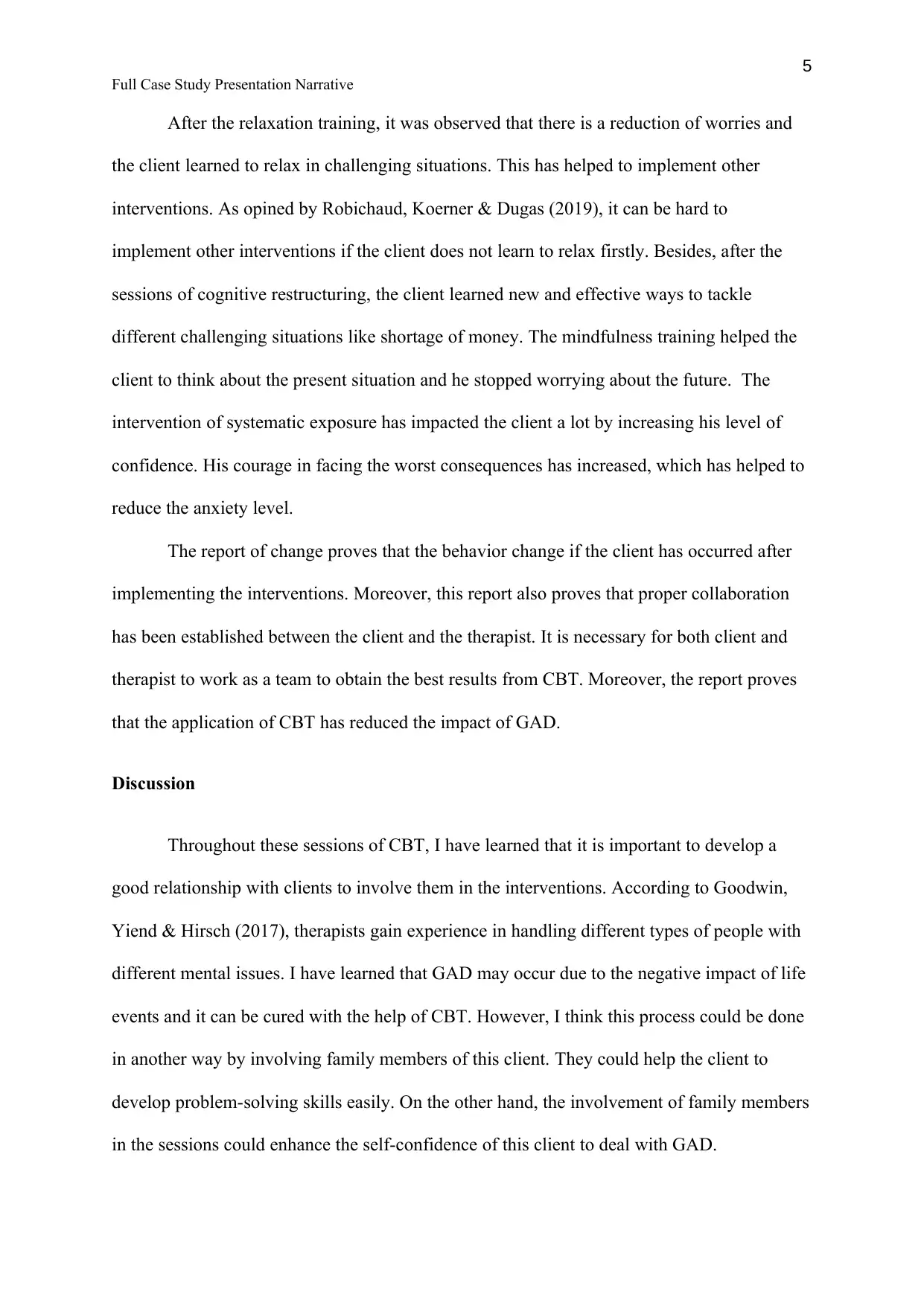
5
Full Case Study Presentation Narrative
After the relaxation training, it was observed that there is a reduction of worries and
the client learned to relax in challenging situations. This has helped to implement other
interventions. As opined by Robichaud, Koerner & Dugas (2019), it can be hard to
implement other interventions if the client does not learn to relax firstly. Besides, after the
sessions of cognitive restructuring, the client learned new and effective ways to tackle
different challenging situations like shortage of money. The mindfulness training helped the
client to think about the present situation and he stopped worrying about the future. The
intervention of systematic exposure has impacted the client a lot by increasing his level of
confidence. His courage in facing the worst consequences has increased, which has helped to
reduce the anxiety level.
The report of change proves that the behavior change if the client has occurred after
implementing the interventions. Moreover, this report also proves that proper collaboration
has been established between the client and the therapist. It is necessary for both client and
therapist to work as a team to obtain the best results from CBT. Moreover, the report proves
that the application of CBT has reduced the impact of GAD.
Discussion
Throughout these sessions of CBT, I have learned that it is important to develop a
good relationship with clients to involve them in the interventions. According to Goodwin,
Yiend & Hirsch (2017), therapists gain experience in handling different types of people with
different mental issues. I have learned that GAD may occur due to the negative impact of life
events and it can be cured with the help of CBT. However, I think this process could be done
in another way by involving family members of this client. They could help the client to
develop problem-solving skills easily. On the other hand, the involvement of family members
in the sessions could enhance the self-confidence of this client to deal with GAD.
Full Case Study Presentation Narrative
After the relaxation training, it was observed that there is a reduction of worries and
the client learned to relax in challenging situations. This has helped to implement other
interventions. As opined by Robichaud, Koerner & Dugas (2019), it can be hard to
implement other interventions if the client does not learn to relax firstly. Besides, after the
sessions of cognitive restructuring, the client learned new and effective ways to tackle
different challenging situations like shortage of money. The mindfulness training helped the
client to think about the present situation and he stopped worrying about the future. The
intervention of systematic exposure has impacted the client a lot by increasing his level of
confidence. His courage in facing the worst consequences has increased, which has helped to
reduce the anxiety level.
The report of change proves that the behavior change if the client has occurred after
implementing the interventions. Moreover, this report also proves that proper collaboration
has been established between the client and the therapist. It is necessary for both client and
therapist to work as a team to obtain the best results from CBT. Moreover, the report proves
that the application of CBT has reduced the impact of GAD.
Discussion
Throughout these sessions of CBT, I have learned that it is important to develop a
good relationship with clients to involve them in the interventions. According to Goodwin,
Yiend & Hirsch (2017), therapists gain experience in handling different types of people with
different mental issues. I have learned that GAD may occur due to the negative impact of life
events and it can be cured with the help of CBT. However, I think this process could be done
in another way by involving family members of this client. They could help the client to
develop problem-solving skills easily. On the other hand, the involvement of family members
in the sessions could enhance the self-confidence of this client to deal with GAD.
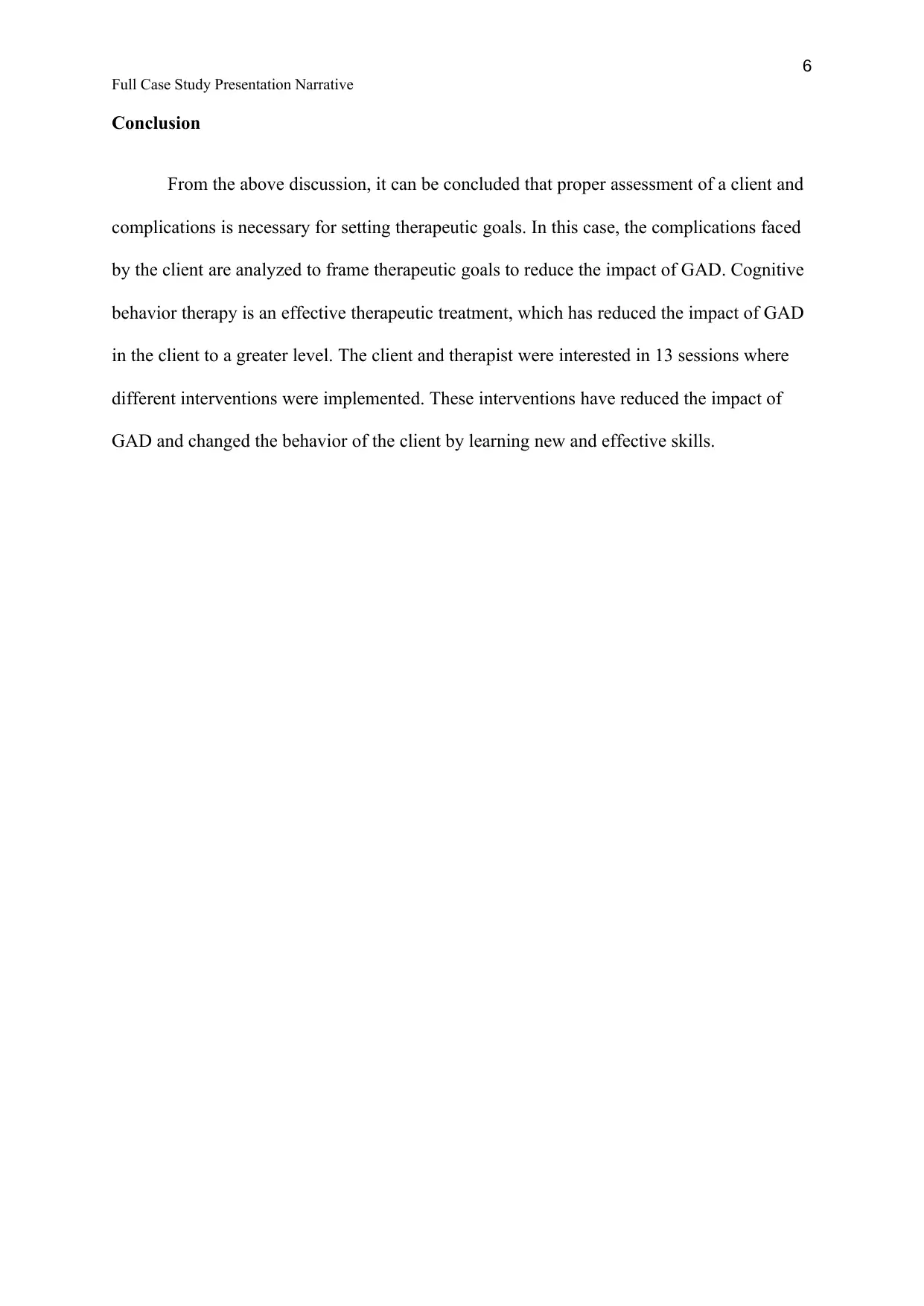
6
Full Case Study Presentation Narrative
Conclusion
From the above discussion, it can be concluded that proper assessment of a client and
complications is necessary for setting therapeutic goals. In this case, the complications faced
by the client are analyzed to frame therapeutic goals to reduce the impact of GAD. Cognitive
behavior therapy is an effective therapeutic treatment, which has reduced the impact of GAD
in the client to a greater level. The client and therapist were interested in 13 sessions where
different interventions were implemented. These interventions have reduced the impact of
GAD and changed the behavior of the client by learning new and effective skills.
Full Case Study Presentation Narrative
Conclusion
From the above discussion, it can be concluded that proper assessment of a client and
complications is necessary for setting therapeutic goals. In this case, the complications faced
by the client are analyzed to frame therapeutic goals to reduce the impact of GAD. Cognitive
behavior therapy is an effective therapeutic treatment, which has reduced the impact of GAD
in the client to a greater level. The client and therapist were interested in 13 sessions where
different interventions were implemented. These interventions have reduced the impact of
GAD and changed the behavior of the client by learning new and effective skills.

7
Full Case Study Presentation Narrative
Reference list
Goodwin, H., Yiend, J., & Hirsch, C. R. (2017). Generalized Anxiety Disorder, worry and
attention to threat: A systematic review. Clinical Psychology Review, 54, 107-122.
Retrieved from:
https://pages.uncc.edu/richard-mcanulty/wp-content/uploads/sites/268/2017/08/
Generalized-Anxiety-Disorder-worry-and-attention-to-threat-A-systematic-review.pdf
Hallion, L. S., Tolin, D. F., & Diefenbach, G. J. (2019). Enhanced cognitive control over
task-irrelevant emotional distractors in generalized anxiety disorder versus obsessive-
compulsive disorder. Journal of anxiety disorders, 64, 71-78. Retrieved from:
https://www.cnmalab.com/uploads/8/9/1/6/89166808/hallion_et_al._2017_cognitive_
control_in_generalized_anxiety_disorder.pdf
Janse, P. D., De Jong, K., Van Dijk, M. K., Hutschemaekers, G. J., & Verbraak, M. J. (2017).
Improving the efficiency of cognitive-behavioural therapy by using formal client
feedback. Psychotherapy Research, 27(5), 525-538. Retrieved from:
https://www.researchgate.net/profile/Marc_Verbraak/publication/299412553_Improvi
ng_the_efficiency_of_cognitive-
behavioural_therapy_by_using_formal_client_feedback/links/
59d232b00f7e9b4fd7fc69a1/Improving-the-efficiency-of-cognitive-behavioural-
therapy-by-using-formal-client-feedback.pdf
Jones, C., Hacker, D., Meaden, A., Cormac, I., Irving, C. B., Xia, J., ... & Chen, J. (2018).
Cognitive behavioural therapy plus standard care versus standard care plus other
psychosocial treatments for people with schizophrenia. Cochrane Database of
Systematic Reviews, (11). Retrieved from: https://scholar.google.com/scholar?
Full Case Study Presentation Narrative
Reference list
Goodwin, H., Yiend, J., & Hirsch, C. R. (2017). Generalized Anxiety Disorder, worry and
attention to threat: A systematic review. Clinical Psychology Review, 54, 107-122.
Retrieved from:
https://pages.uncc.edu/richard-mcanulty/wp-content/uploads/sites/268/2017/08/
Generalized-Anxiety-Disorder-worry-and-attention-to-threat-A-systematic-review.pdf
Hallion, L. S., Tolin, D. F., & Diefenbach, G. J. (2019). Enhanced cognitive control over
task-irrelevant emotional distractors in generalized anxiety disorder versus obsessive-
compulsive disorder. Journal of anxiety disorders, 64, 71-78. Retrieved from:
https://www.cnmalab.com/uploads/8/9/1/6/89166808/hallion_et_al._2017_cognitive_
control_in_generalized_anxiety_disorder.pdf
Janse, P. D., De Jong, K., Van Dijk, M. K., Hutschemaekers, G. J., & Verbraak, M. J. (2017).
Improving the efficiency of cognitive-behavioural therapy by using formal client
feedback. Psychotherapy Research, 27(5), 525-538. Retrieved from:
https://www.researchgate.net/profile/Marc_Verbraak/publication/299412553_Improvi
ng_the_efficiency_of_cognitive-
behavioural_therapy_by_using_formal_client_feedback/links/
59d232b00f7e9b4fd7fc69a1/Improving-the-efficiency-of-cognitive-behavioural-
therapy-by-using-formal-client-feedback.pdf
Jones, C., Hacker, D., Meaden, A., Cormac, I., Irving, C. B., Xia, J., ... & Chen, J. (2018).
Cognitive behavioural therapy plus standard care versus standard care plus other
psychosocial treatments for people with schizophrenia. Cochrane Database of
Systematic Reviews, (11). Retrieved from: https://scholar.google.com/scholar?
Paraphrase This Document
Need a fresh take? Get an instant paraphrase of this document with our AI Paraphraser
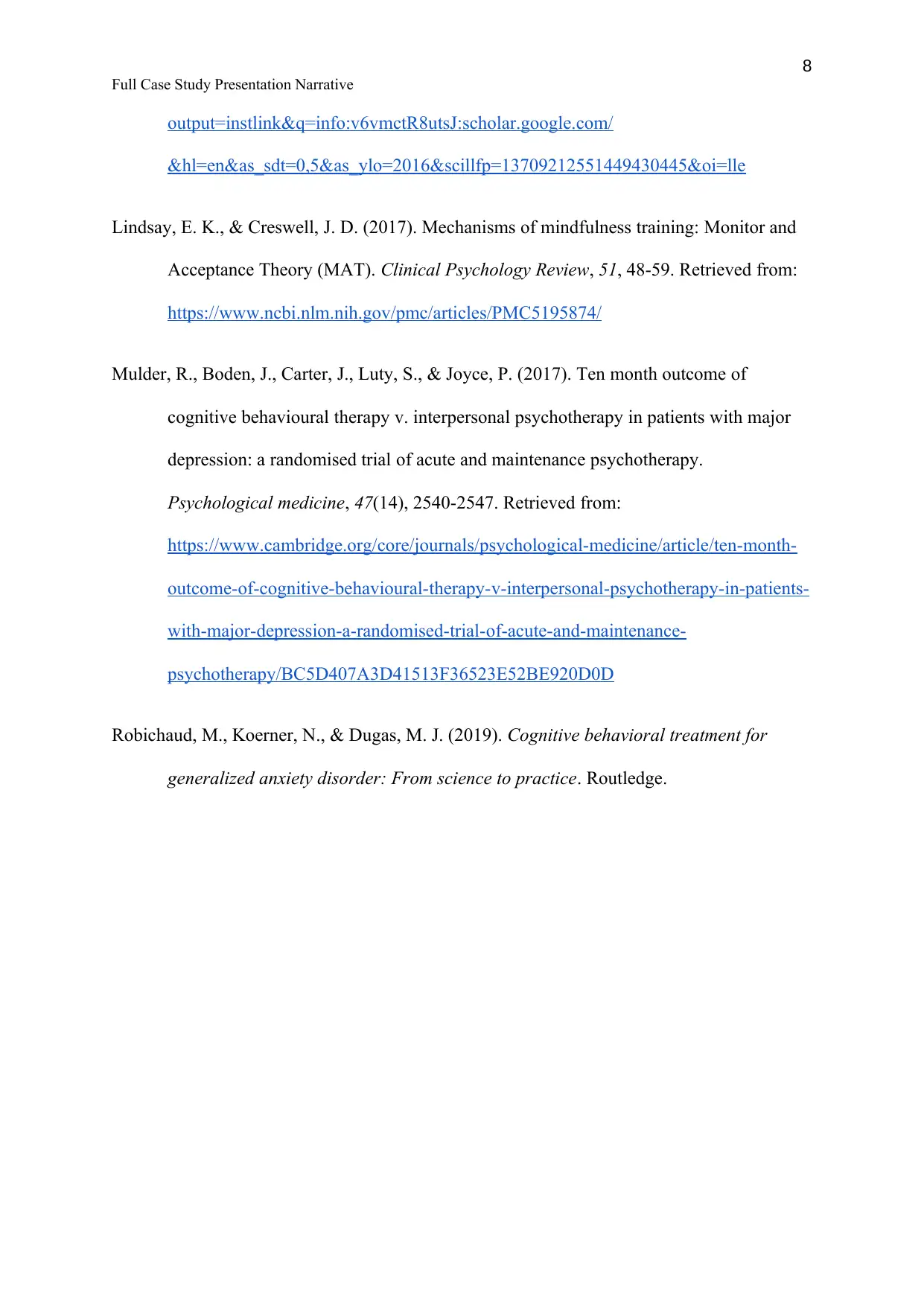
8
Full Case Study Presentation Narrative
output=instlink&q=info:v6vmctR8utsJ:scholar.google.com/
&hl=en&as_sdt=0,5&as_ylo=2016&scillfp=13709212551449430445&oi=lle
Lindsay, E. K., & Creswell, J. D. (2017). Mechanisms of mindfulness training: Monitor and
Acceptance Theory (MAT). Clinical Psychology Review, 51, 48-59. Retrieved from:
https://www.ncbi.nlm.nih.gov/pmc/articles/PMC5195874/
Mulder, R., Boden, J., Carter, J., Luty, S., & Joyce, P. (2017). Ten month outcome of
cognitive behavioural therapy v. interpersonal psychotherapy in patients with major
depression: a randomised trial of acute and maintenance psychotherapy.
Psychological medicine, 47(14), 2540-2547. Retrieved from:
https://www.cambridge.org/core/journals/psychological-medicine/article/ten-month-
outcome-of-cognitive-behavioural-therapy-v-interpersonal-psychotherapy-in-patients-
with-major-depression-a-randomised-trial-of-acute-and-maintenance-
psychotherapy/BC5D407A3D41513F36523E52BE920D0D
Robichaud, M., Koerner, N., & Dugas, M. J. (2019). Cognitive behavioral treatment for
generalized anxiety disorder: From science to practice. Routledge.
Full Case Study Presentation Narrative
output=instlink&q=info:v6vmctR8utsJ:scholar.google.com/
&hl=en&as_sdt=0,5&as_ylo=2016&scillfp=13709212551449430445&oi=lle
Lindsay, E. K., & Creswell, J. D. (2017). Mechanisms of mindfulness training: Monitor and
Acceptance Theory (MAT). Clinical Psychology Review, 51, 48-59. Retrieved from:
https://www.ncbi.nlm.nih.gov/pmc/articles/PMC5195874/
Mulder, R., Boden, J., Carter, J., Luty, S., & Joyce, P. (2017). Ten month outcome of
cognitive behavioural therapy v. interpersonal psychotherapy in patients with major
depression: a randomised trial of acute and maintenance psychotherapy.
Psychological medicine, 47(14), 2540-2547. Retrieved from:
https://www.cambridge.org/core/journals/psychological-medicine/article/ten-month-
outcome-of-cognitive-behavioural-therapy-v-interpersonal-psychotherapy-in-patients-
with-major-depression-a-randomised-trial-of-acute-and-maintenance-
psychotherapy/BC5D407A3D41513F36523E52BE920D0D
Robichaud, M., Koerner, N., & Dugas, M. J. (2019). Cognitive behavioral treatment for
generalized anxiety disorder: From science to practice. Routledge.
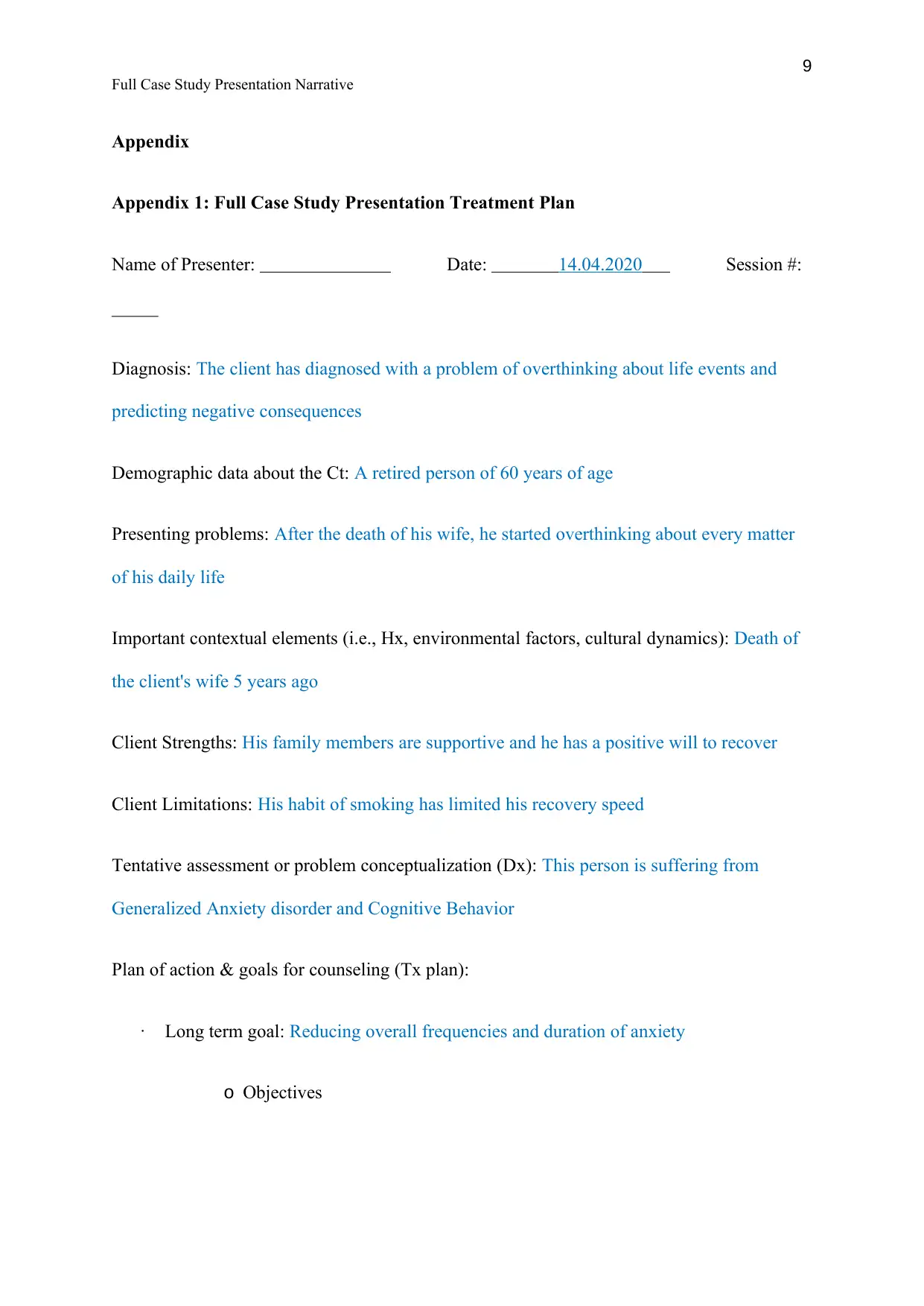
9
Full Case Study Presentation Narrative
Appendix
Appendix 1: Full Case Study Presentation Treatment Plan
Name of Presenter: Date: 14.04.2020 Session #:
_____
Diagnosis: The client has diagnosed with a problem of overthinking about life events and
predicting negative consequences
Demographic data about the Ct: A retired person of 60 years of age
Presenting problems: After the death of his wife, he started overthinking about every matter
of his daily life
Important contextual elements (i.e., Hx, environmental factors, cultural dynamics): Death of
the client's wife 5 years ago
Client Strengths: His family members are supportive and he has a positive will to recover
Client Limitations: His habit of smoking has limited his recovery speed
Tentative assessment or problem conceptualization (Dx): This person is suffering from
Generalized Anxiety disorder and Cognitive Behavior
Plan of action & goals for counseling (Tx plan):
· Long term goal: Reducing overall frequencies and duration of anxiety
o Objectives
Full Case Study Presentation Narrative
Appendix
Appendix 1: Full Case Study Presentation Treatment Plan
Name of Presenter: Date: 14.04.2020 Session #:
_____
Diagnosis: The client has diagnosed with a problem of overthinking about life events and
predicting negative consequences
Demographic data about the Ct: A retired person of 60 years of age
Presenting problems: After the death of his wife, he started overthinking about every matter
of his daily life
Important contextual elements (i.e., Hx, environmental factors, cultural dynamics): Death of
the client's wife 5 years ago
Client Strengths: His family members are supportive and he has a positive will to recover
Client Limitations: His habit of smoking has limited his recovery speed
Tentative assessment or problem conceptualization (Dx): This person is suffering from
Generalized Anxiety disorder and Cognitive Behavior
Plan of action & goals for counseling (Tx plan):
· Long term goal: Reducing overall frequencies and duration of anxiety
o Objectives

10
Full Case Study Presentation Narrative
- To help the client to lead a normal life in the future with his family
members
- To help his family members to get rid of the misbehaviors of the
client influenced by anxiety
· Short term goal: Implementing coping skills
o Objectives
- To help the client to develop the skill of thinking positively
- To help the client to become ready to face any consequences
Intervention strategies:
1. 3 sessions of relaxation training
2. 3 sessions of cognitive restructuring
3. 2 sessions of mindfulness
4. 2 sessions of systematic exposure
5. 3 sessions for problem-solving training
Concerns or problems surrounding this session/case: It was challenging to gain the trust of
the client and build a good relationship with him
Evaluation of Progress: It has been found that gradually, the client started cooperating with
the therapist to deal with GAD
Full Case Study Presentation Narrative
- To help the client to lead a normal life in the future with his family
members
- To help his family members to get rid of the misbehaviors of the
client influenced by anxiety
· Short term goal: Implementing coping skills
o Objectives
- To help the client to develop the skill of thinking positively
- To help the client to become ready to face any consequences
Intervention strategies:
1. 3 sessions of relaxation training
2. 3 sessions of cognitive restructuring
3. 2 sessions of mindfulness
4. 2 sessions of systematic exposure
5. 3 sessions for problem-solving training
Concerns or problems surrounding this session/case: It was challenging to gain the trust of
the client and build a good relationship with him
Evaluation of Progress: It has been found that gradually, the client started cooperating with
the therapist to deal with GAD
Secure Best Marks with AI Grader
Need help grading? Try our AI Grader for instant feedback on your assignments.

11
Full Case Study Presentation Narrative
Prognosis: The 13 sessions of Cognitive Behavioral Therapy will help the client to handle
problems of GAD in the future if required
Full Case Study Presentation Narrative
Prognosis: The 13 sessions of Cognitive Behavioral Therapy will help the client to handle
problems of GAD in the future if required
1 out of 11
Related Documents
Your All-in-One AI-Powered Toolkit for Academic Success.
+13062052269
info@desklib.com
Available 24*7 on WhatsApp / Email
![[object Object]](/_next/static/media/star-bottom.7253800d.svg)
Unlock your academic potential
© 2024 | Zucol Services PVT LTD | All rights reserved.




